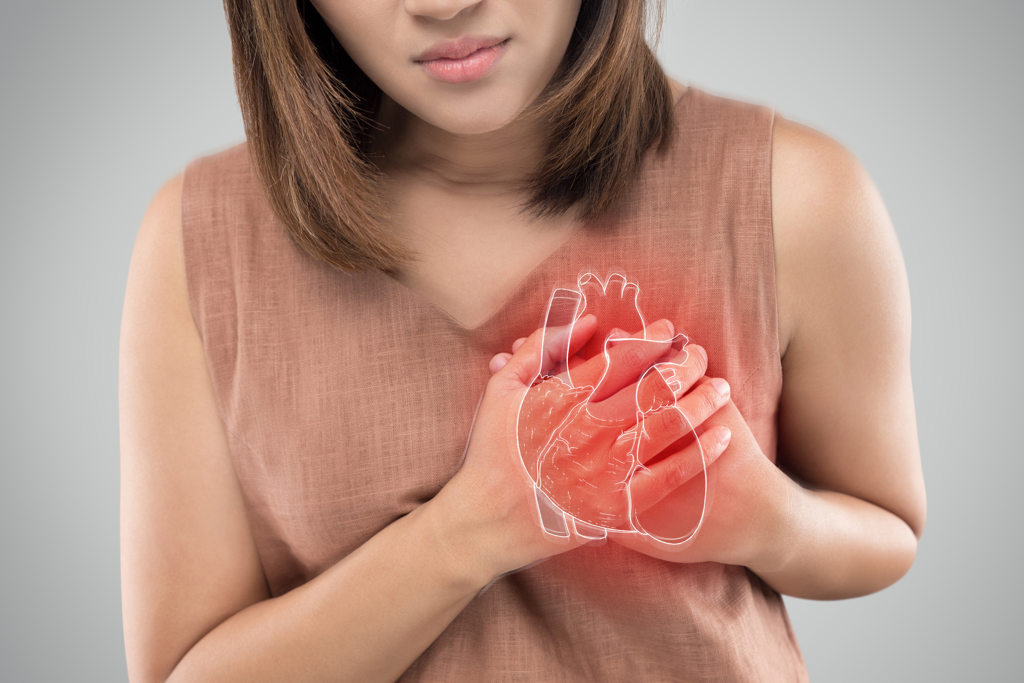Did You Know Women Often Experience Heart Attack Symptoms Differently Than Men?
Updated December 31, 2022
Heart Disease in Women: Know the Facts
Heart disease is the leading cause of death for women in the United States and the statistics are sobering. According to the Centers for Disease Control and Prevention (CDC), heart disease kills one out of every five women each year, and it is particularly prevalent in women over 35 years of age in our region. The CDC also reports that one in 16 women age 20 and older have coronary artery disease (CAD), the most common type of heart disease.

What is heart disease?
Heart disease refers to several types of heart conditions that happen gradually over time including CAD, peripheral arterial disease, aortic disease and stroke.
Coronary artery disease, which is the leading cause of heart attacks, is caused by a buildup of plaque in the walls of the arteries that supply blood to the heart. The plaque buildup causes the arteries to narrow and block blood flow. In peripheral artery disease, narrowed arteries reduce blood flow to the arms and legs. Aortic disease occurs when the valve between the lower left ventricle and the aorta does not keep blood flowing in the correct direction through the heart. Finally, a stroke happens when a blood vessel that carries oxygen to the brain is either blocked or bursts.
“We need to raise awareness about heart disease in women, because they may not have chest discomfort, arm or jaw pain or they may attribute symptoms they are having to some other condition,” explained Adil Waheed, DO, an interventional cardiologist with Penn Highlands Healthcare in Monongahela, Pennsylvania. “They may experience symptoms that resemble acid reflux, the flu or extreme fatigue and ignore the warning signs until it’s too late.”
What are the symptoms and how is heart disease diagnosed?
Symptoms of heart disease may occur when a person is performing routine activities, such as cooking or driving, or even when they are resting. Symptoms include: angina which is dull and heavy discomfort or a fullness in the chest as well as pain in the throat, neck, jaw, upper abdomen or back. Other symptoms may include fatigue, nausea or vomiting.
For a diagnosis, your healthcare provider will examine you and review your personal and family medical history. Many different tests may then be performed such as blood tests; a chest x-ray; electrocardiogram; halter monitoring; echocardiogram; a stress test on a treadmill or stationary bike; heart CT scan; cardiac catheterization; or heart MRI scan.
What are the treatments?
“The treatment prescribed will depend on the cause and type of heart damage,” explained Dr. Waheed. “Sometimes a person may be asked to make lifestyle changes. If the changes are not successful, medications may be needed to control the symptoms and prevent complications or a procedure or surgery may be needed.”
Who is at risk?
Some people are at an increased risk for heart disease. If you have high blood pressure, diabetes, are overweight, do not receive adequate physical activity, drink alcohol or smoke, you are at higher risk. Approximately half of all people in the United States have at least one risk factor for heart disease.
You can lower your risk by regularly checking your blood pressure, making healthy food decisions, exercising regularly, limiting your alcohol intake, managing your stress and quitting smoking.
Most importantly, talk to your primary care provider about your family history, risk factors and the steps you can take to reduce the threat to your health.
“By knowing the risks and symptoms, you could save your life or the life of someone else,” said Dr. Waheed.
Penn Highlands cardiologists, cardiac surgeons and heart health experts treat all types of heart problems from chronic conditions, such as congestive heart failure, to emergency conditions, such as heart attacks. For more information, visit Heart Care

